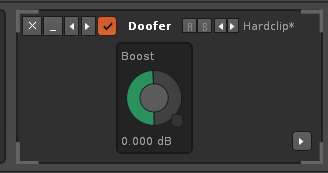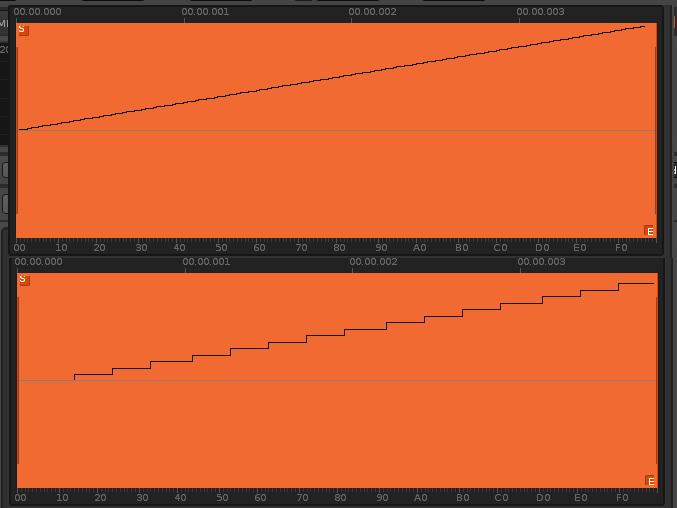We all are!
It creates a distort effect. These are the settings for gainer and compressor:

This is the result:

If i lower the threshold of the compressor it gets a hedge-trimmer-sword-shape.
Settings:

and result:

Oh, sorry, I remembered the effect incorrectly, sorry for this. Still it makes an interesting distortion effect that affects mostly the bass frequencies.
I’ve still something else for you as a solution. Put one gainers gainer before and one after the distortion device in razor mode, 0% drive, 100%wet 0%dry. Then set the gainer before it to -3.745db, and the gainer after it to 3.745db. Then the clipping threshold should be more or less exactly at 0.0db. So you can boost the signal before the distortion to clip it more, and lower the gain after it to move the clipping threshold.
This gain I found via the master peak meter. Maybe it is possible to find out more exact values for the gain by resampling stuff through the effect, I’ll try to investigate it later.
you could put this chain in a doofer, save preset, and have yourself a native hard clip to drop in wherever you like, like so:
DYN- HARD CLIP.xrdp (4.5 KB)
Yes, another useful preset
I also think Baphy is missing some point: He / she (? sorry I am confused now) always looks only at the peaks.
But you could also take “upwards compression” into account, using the Renoise distortion device, since you can also mix in the dry amount. For example, try this: set it up for heavy clip distortion on a drum bus, and then blend the distortion into the dry signal only by 5% or so. The result will sound more dense, even nice, also subjectively louder and you still reduced your peak values (while even preserving the original transients).
+1 for native clipper. I’m using the free & great Gclip vst atm, but having this natively as an offline effect inside the sample editor would be great too imo. Some kind of threshold slider setting upper and lower waveform boundaries and pressing the clip icon auto truncating the peaks ![]() .
.
+1, it would be good to make a native device from the master soft clipping algo, and implement a db threshold control for it.
+1 for native soft/hard clipper
THere is already a hard clipper in renoise
Distortion set to razor = hard clipper
And a (fixed) soft clipper, too. For all other cases, just use one of the many good and free clipper plugins. IMHO no need to spend any dev time here.
PeakEater (IMO best one): Release v0.8.2 · vvvar/PeakEater · GitHub
FreeClip (not developed anymore): Free Clip | Venn Audio
GClip (basic but ok): GVST - GClip
PeakEater is based on FreeClip
Made simplified Doofer for me. Just one Boost knob. It will clip at 0db. You can boost or reduce input level, double click will set it to 0db boost.
Hardclip.xrdp (5.1 KB)

Its good to have this basic effects native in Renoise.
I had noticed this before, but it’s rarely caused problems for me in practice. It seems that the razor distortion setting causes decimation. In the past I just noticed some high frequency distortion harmonics that show up if you boost the highs after clipping (which I almost never do). Try processing a sample with this (60db cut/boost) to see what I mean:
razor-decimation.xrdp (7.5 KB)
This is maybe an optimization involving integer math? Personally, I would be happy enough if the next version of Renoise removed this as the default option and did ordinary hard clipping. The level of the decimation is so low that I couldn’t really call it part of the ‘character’ of the distortion, but I can imagine that some effects chains might make it more prominent, in a good way. So idk. All I know is I would at least like a checkbox to disable this.
Edit: uh more on topic, though:
Tiny peak transients can be really bad for dynamics processing despite not really adding anything to a sound. Clipping is a viable way of dealing with this. I watched a few of the CTZ videos mentioned in this thread, and this is actually one of the points Baph mentions, clipping allows peak limiters to target ‘real’ peaks more effectively, with less work being done on sporadic peaks, which cause pumping artifacts, which I can only describe as the compressor sounding like it’s trying strangle something. I think CTZ is worth experimenting with for this reason, though it is not the only way of mitigating this problem. Anyway, I’ve had some good results with it, but I have not done a scientific comparison.
Also I would see Baphy’s theory questionable. It might be useful for specific transients, maybe low frequency stuff e.g. unison, but actually these assumptions already contradict the maths. A clipper on a full bandwidth signal will mostly only cut away low frequency transients, since low frequencies are way more attenuated than high frequenies. In other words, low freq wave is the carrier wave for the high frequency, so only on the extreme positions it will also clip high frequencies, and then only asymmetrical. So the whole premise seems to be wrong already.
It really depends on the audio source, not every audio source will have more amplitude in the lows and even if a source does have more amplitude in its lows it shouldn’t make a difference since the ideia is to clip for dynamic control and to make clipping quick and “transparent”.
Also I can’t really hear a good result in Baphy’s examples (with all respect for her tutorials and experiments). All sounds sound too even then, coloration is lost. This might be good for dubstep or so, but I would assume not for the most genres.
@ToybOx: I actually came across that video from baphometrix before,it’s funny, for how much time and technical knowledge he has,his mixes are completely lifeless,all the colours just drained out of all the sounds,terrible stuff
I also agree with that but the idea of cascading clipping/limiting for precise dynamic control isn’t her invention, far from it it’s standard practice especially within the electronic scene. I’ve spoken with some industry mixing engineers and they’re aware of the concepts behind the method and trust me they’re not new.
So don’t let your impressions of Baphometrix discourage you from learning the concepts she teaches and experimenting with them cuz they’re very very very useful.
Wrong. The majority of clippers do not have weighting for specific frequencies. Also, you’re not necessarily working with LUFS metering (which put emphasis in psychoacoustics), but with “raw” peaks. In fact, most transients are not even in the low range, but in the mids and highs.
Let’s take a kick sample, for example: If the low frequencies are concentrated mid crest factor (between peaks and noise floor), they won’t even be affected by the clipping - but only the initial “click” of the transient (which will probably be a high frequency, because that’s how kicks work, they quickly go up and down in pitch). The clipping also won’t generate audible distortion.
However, you’re not entirely wrong. If we take this same kick example to a Limiter things can start to go “wrong” - but only if you exaggerate the release and treshold. If you do exaggerate, it will result in unwanted movement, which may in fact screw up your low frequencies. Even then, that’s avoidable.
Correct. Baphometrix has been very clear regarding this. She has stated multiple times that these techniques are not meant for every genre or arrangement style. You should only use CTZ if you have a clear arrangement focused in loudness, and dubstep is the perfect genre example for that: you have spaced kicks and snares, and enough time for limiters to do their job without squashing down your mix. If you take these techniques and apply them to a metal song or an orchestra… well, that’s a whole other story… It definitely won’t work, because you have different elements activating your plugins. Even then, you can still apply some of the tricks in specific instruments (specially the drums) and leave others untouched.
This can actually result in the same problems I just discussed. A multiband clipper will have weighting, so it will affect different frequencies in different ways. Same for a multiband limiter (such as DMG Audio Limitless, which is my personal favorite). Aside from that, they tend to be VERY VERY CPU heavy and focused in mastering. I’d stick with a single band clipper and only use a multiband one for mastering. But I just use Limitless which has a pre-limiter clipper.
Exactly. Most of this knowledge has been used for decades already. She just placed some effort into making a systematic approach for it.
In the past I just noticed some high frequency distortion harmonics that show up if you boost the highs after clipping
Uh, on further review I knew exactly what was going on, but I just forgot. I pointed it out in help thread… about a decade ago. I swear I’ve seen someone mention this maybe once before aside from this thread. I can’t be the only one who finds this a little weird / concerning / interesting right? Does anyone know why this happens?
I have one. This is an example. You can go with easy to around -9÷-8LUFS (int). You need to use two instances od Distortion stock effect (gently tweak all parameters, any move for even 0.05 matters!), one set for Razor and one for Shape:
Indeed. Though it has to be stressed that this is very likely down to his aesthetic and ear rather than the CTZ method necessarily lending itself to lifeless mixes.

